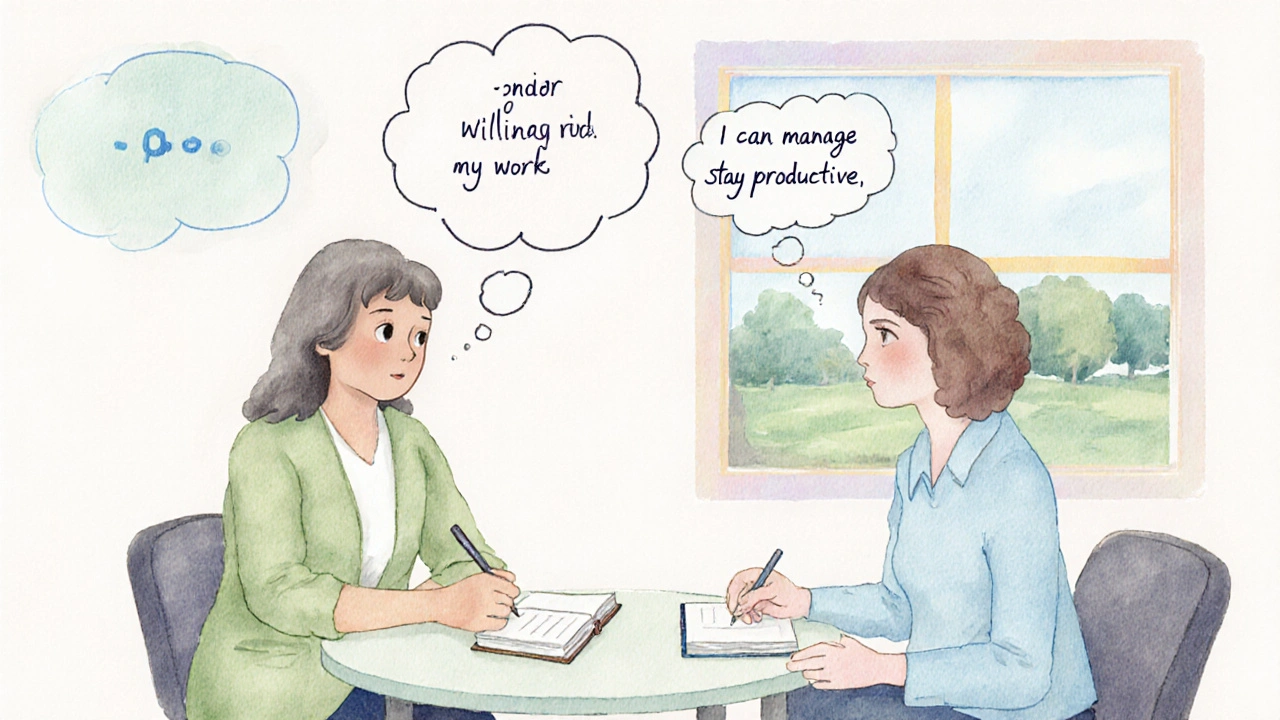Tinnitus Impact Calculator
Tinnitus Severity Assessment
Your Results
Enter your tinnitus details and click "Calculate Impact & Benefits" to see personalized insights.
About CBT for Tinnitus
Cognitive Behavioral Therapy (CBT) is an evidence-based treatment that helps manage the emotional distress caused by tinnitus. It focuses on changing thought patterns and behaviors related to the ringing sound.
When a constant high‑pitched buzz turns everyday life into a stressful grind, many wonder if talking to a therapist can actually quiet that noise. cognitive behavioral therapy for tinnitus has emerged as a front‑line option that doesn’t rely on pills or gadgets, but on reshaping the way the brain reacts to the ringing.
What is Tinnitus and Why Does It Feel So Bad?
Tinnitus is the perception of sound-often a ringing, hissing, or clicking-without an external source. About 15% of adults in the UK report occasional tinnitus, and roughly 1-2% experience it so intensely that it disrupts sleep, work, or relationships.
The condition itself isn’t a disease; it’s a symptom that can stem from hearing loss, ear infections, loud‑music exposure, or even stress. The real problem is the brain’s alarm system: it starts treating the phantom sound as a threat, activating the limbic system (the part that handles emotions) and heightening anxiety.
What Exactly Is Cognitive Behavioral Therapy?
Cognitive Behavioral Therapy (CBT) is a structured, goal‑oriented psychotherapy that examines the link between thoughts, feelings, and behaviours. In a typical CBT session, a licensed therapist helps the client identify unhelpful thoughts (e.g., “I’ll never be able to focus because of this ringing”) and replace them with realistic alternatives.
CBT was first popularised for mood disorders, but researchers discovered that its principles work equally well for chronic sensory symptoms like tinnitus.
How CBT Targets the Brain’s Reaction to Ringing
The core idea is to break the vicious cycle: ringing → anxiety → more awareness of ringing → heightened distress**. CBT intervenes at two points:
- Cognitive restructuring: Clients learn to challenge catastrophic thoughts. For example, swapping “My tinnitus will ruin my job” with “I can use coping strategies to stay productive”.
- Behavioural techniques: Scheduling pleasant activities, practising relaxation, and using sound enrichment (soft background noise) reduces the brain’s focus on the phantom sound.
Neuroimaging studies from 2023‑2024 show that CBT reduces activity in the auditory cortex and amygdala, meaning the brain literally becomes less reactive to the phantom noise.
Typical CBT Programme for Tinnitus
A standard programme runs for 6‑12 weekly sessions, each lasting about 45‑60 minutes. Below is a typical flow:
- Assessment: An audiologist or therapist evaluates the severity of tinnitus, associated hearing loss, and emotional impact.
- Psycho‑education: Clients learn how the brain creates tinnitus and why stress makes it louder.
- Thought monitoring: Using a diary, patients note moments when the ringing feels worst and the thoughts that accompany it.
- Restructuring exercises: Guided worksheets help replace negative predictions with balanced statements.
- Relaxation training: Breathing, progressive muscle relaxation, or guided imagery reduce the sympathetic “fight‑or‑flight” response.
- Sound enrichment: Low‑level background sounds (white noise, nature sounds) are introduced to mask the ringing without becoming a new dependency.
- Relapse prevention: A final session solidifies coping tools and creates a personal action plan.
Most therapists integrate mindfulness exercises because staying present reduces the brain’s habit of catastrophising the sound.

Effectiveness: What the Numbers Say
A meta‑analysis of 18 randomised controlled trials (RCTs) published in the Journal of Otolaryngology (2024) reported an average 30% reduction in tinnitus distress scores (Tinnitus Handicap Inventory) for participants who completed CBT, compared with a 10% drop in control groups receiving standard care.
Key findings:
- Improvement persisted at 12‑month follow‑up in 70% of cases.
- Patients with co‑occurring depression or anxiety showed the biggest gains, highlighting CBT’s dual benefit.
- Even modest attendance (5 sessions) produced noticeable reductions in worry about tinnitus.
CBT Compared With Other Tinnitus Treatments
| Option | Primary Goal | Typical Duration | Evidence Strength (2024) | Cost (UK, approx.) |
|---|---|---|---|---|
| CBT | Reduce distress & change perception | 6‑12 weeks | Strong (multiple RCTs) | £50‑£80 per session |
| Sound Therapy (maskers, hearing aids) | Mask or habituate to sound | Ongoing | Moderate (observational studies) | £200‑£1,200 (device) |
| Medication (e.g., antidepressants) | Address co‑morbid mood issues | Varies | Limited specific to tinnitus | £15‑£30 per month |
| Mindfulness‑Based Stress Reduction | Lower stress response | 8‑10 weeks | Emerging (small RCTs) | £30‑£60 per session |
CBT stands out because it directly targets the emotional reaction rather than trying to silence the sound itself. For many, a combined approach-CBT plus sound enrichment-delivers the best results.
Getting Started: Practical Steps for Readers
- Schedule an appointment with your local audiologist or GP to rule out any treatable medical cause.
- Ask about a referral to a therapist trained in tinnitus‑specific CBT. In the UK, many NHS trusts and private clinics list this expertise.
- Prepare a simple diary of when the ringing feels most intrusive and what you were thinking at the time.
- Commit to the full programme-research shows that dropping out early reduces the chance of lasting benefit.
- Consider supplementing sessions with a low‑level white‑noise app or a bedside fan; keep the volume below35dB to avoid new hearing strain.
If you’re on a tight budget, some charities (e.g., British Tinnitus Association) offer group‑based CBT workshops at reduced cost.
Common Pitfalls and How to Avoid Them
- Expecting a magic cure: CBT eases the distress, not the sound itself. Set realistic goals like “I can tolerate the ringing while working”.
- Skipping home practice: The exercises are where change happens. Treat the daily diary and relaxation drills as non‑negotiable.
- Choosing an unqualified therapist: Look for credentials such as a chartered psychologist with experience in audiology‑related CBT.
- Relying solely on medication: Drugs may help mood but won’t address the brain‑sound loop the way CBT does.
Future Directions: Where CBT for Tinnitus Is Heading
Digital health is reshaping access. In 2025, several NHS‑approved apps deliver guided CBT modules, complete with video demos and interactive thought‑tracking. Early pilots report adherence rates comparable to face‑to‑face therapy, suggesting a hybrid model could broaden reach.
Researchers are also exploring neurofeedback combined with CBT, aiming to teach patients to down‑regulate auditory cortex activity in real time. While still experimental, initial trials hint at faster symptom relief.

Frequently Asked Questions
Can CBT completely eliminate tinnitus?
Most people experience a reduction in distress rather than total silence. The goal is to make the ringing less intrusive so daily life isn’t dominated by it.
How long does a typical CBT programme last?
Usually 6‑12 weekly sessions, each about an hour. Some clinics offer intensive 2‑day workshops, but the weekly model shows the best long‑term retention.
Is CBT for tinnitus covered by the NHS?
In many regions, a GP referral to a qualified therapist or a hearing‑loss service can trigger NHS coverage, especially when tinnitus is linked to anxiety or depression.
Do I need any special equipment for CBT?
No. All you need is a notebook for thought logs and a quiet space for the relaxation exercises. Some therapists may suggest a low‑volume sound generator, but it’s optional.
Can I combine CBT with other treatments?
Absolutely. Many clinicians pair CBT with sound therapy, hearing aids, or even medication for co‑existing mood disorders. The combination often yields the strongest improvement.



Naomi Ho on 4 October 2025, AT 16:32 PM
I’ve seen CBT work wonders for folks who can’t quiet the ringing in their ears. The key is to treat the noise as just another background signal instead of a threat. Keeping a simple thought‑log each day helps you spot the patterns that make the distress spike. Pair that with a short relaxation routine before bedtime and you’ll notice sleep getting better fast. Stick with the program for at least six weeks before judging the results.